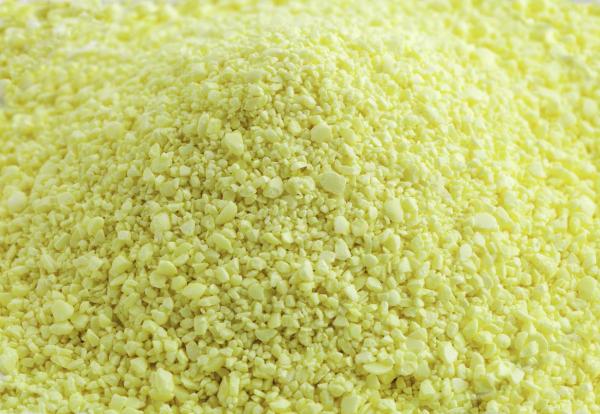Sulfur for Plants - Uses and Benefits


Sulfur is a chemical element. Moreover, it is an essential macromineral for the correct development of all living beings. This does not exclude plants. It works by intervening in various cellular processes that take place within any organism. Sulfur is present in the substrate of plants, the substance which allows them to obtain nutrients for survival. Sometimes low-sulfur soil can be the cause of poor plant growth, although too much sulfur can also be a problem.
If you have a garden or indoor plants, knowing how does sulfur help plants will be helpful in ensuring proper growth. At oneHOWTO, we look at sulfur for plants, understanding its uses and benefits. We also provide a helpful guide on how to use sulfur on your plants.
What is sulfur for plants?
Sulfur is a secondary nutrient which each plant species needs in certain quantities. In the world of gardening and in the agricultural sector it is used as a natural soil fertilizer. It is useful because a low amount of this mineral in the soil means that the plant does not absorb other essential minerals, such as potassium or nitrogen. Sulfur deficiency has easily noticeable consequences for plants. Some of the symptoms of sulfur deficiency in plants are:
- Low growth
- Lack of flowering
- Presence of young leaves that develop with an abnormal yellowish tone
In addition to helping the plant's nutrition process, sulfur as an element present in the soil itself. In part, it determines its alkalinity or acidity levels, something important for providing the optimal growth conditions for the plant. Applied in large quantities, sulfur helps to lower the pH of the substrate, doing so by providing it with a higher degree of acidity.
It is important to remember there are plants and crops that require a more or less acidic type of soil. This is something you will need to determine before applying sulfur to your plants. Many shrubs and other species such as hydrangeas, azaleas or rhododendrons require acidic soils. Controlling sulfur levels is especially important when growing these plants. Also, if you have a garden, keep in mind that some fruits and vegetables, such as strawberries or tomatoes, may also require an extra supply of sulfur, since they grow better in acidic soils.
Finally, the antifungal properties of sulfur stand out among its important functions. These properties make it a powerful ally when it comes to combating the attack of fungi, such as powdery mildew. In addition, it is an effective weapon to control common plant pests. It does so in a natural way, since it promotes the plant's health and strengthens their defenses. This makes them better able to defend themselves against the attack of arachnid pests, such as the red spider, and insects, such as aphids or whiteflies.
When to apply sulfur to plants
If you are going to add sulfur to your plants, whether to provide more nutrients, increase the acidity of the soil or as a preventive measure against possible pests, it is important to do it in the right amounts for each plant.
- As a general rule, the ideal is to use it as a fertilizer in the weeks before the beginning of spring. This will enrich the soil and better ensure the plant has all the minerals it needs at the time of flowering.
- You can also apply sulfur any time you detect the presence of pests. This is the same whether they are insects, fungi or other types. You may be first alerted to them when you see the leaves of your plants start yellowing for no reason.
- When adding the sulfur it is important to remember that you should not do it during the middle of the day, especially in summer. It is best to avoid times when temperatures are higher. As a precaution, the ideal is to apply it in the late afternoon. This is because direct sunlight and excessive heat could cause the sulfur to burn the leaves of the plants.

How to apply sulfur to plants
Adding sulfur to your plants to protect them against pests or give them extra nutrition is simple. You have two ways of carrying out the process. You can apply sulfur powder directly to the soil or diluting a small amount in the irrigation water. In the latter cases, you can spray the plant directly. This is helpful if you have infestation on the plant leaves, stem and other parts above the soil.
It is very important to note that sulfur can be toxic. Precautions need to be made safe application. Use basic protection elements, such as gloves and eyewear. These will protect your hands when putting it in the soil and protect your eyes in case any splashes occur when spraying. You may need to a significant amount, such as when fumigating a large cultivated area. in these cases, it is also important to wear a mask.
- Add sulfur to soil: if you are going to add sulfur to the substrate (recommended to prevent pests or increase soil nutrition) spread it around the plant base, but keep it a few centimeters from the trunk or central stem.
- Sulfur solution in spray: take into account the particular needs of each plant. If you are going to apply the sulfur dissolved in water directly on the leaves, follow the product's instructions regarding the advisable proportion of water to sulfur ratio in each case. If you notice any type of damage to the leaves after application, immediately remove the product with plenty of water.
There are many different natural products we can use on our plants, some of which might not seem useful at first. You can discover another one with our guide to using milk on plants.
If you want to read similar articles to Sulfur for Plants - Uses and Benefits, we recommend you visit our Gardening & plants category.





